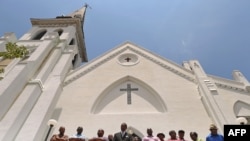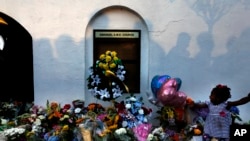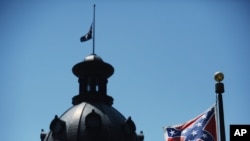The recent deadly shooting in a historic African American church in the U.S. state of South Carolina, this week, that left nine people dead, has brought Zimbabwe and South Africa into the spotlight.
Twenty-one-year-old Dylan Roof, a white American male, who is now in police custody, has a jacket bearing the colonial flags of then Rhodesia and apartheid South Africa, while under Prime Ministers Ian Douglas Smith and Pieter Wilem Botha, respectively.
Many questioning and analyzing the significance of the flags to Roof, who sat through a bible study class at the African Methodist Church in Charleston, before reportedly pulling out a gun and shooting down nine-people, refer to his possible belief in white supremacy.
Those who lived through white-minority rule in Zimbabwe and South Africa, reflect on the time with sadness and anger, over the oppression black Africans were subjected to.
Zimbabwe’s senior minister of state and spokesperson for the ruling Zanu PF party, Ambassador Simon Khaya Moyo, recalled the era as so brutal that it motivated blacks to wage their fight for liberation in the 60s.
“You know we went through a very, very protracted liberation struggle because we were fighting against white supremacy and circularism,” Moyo explained. “Of course, we had to take up arms because we were considered sub-human.”
The sentiment is shared by legendary U.S.-based Zimbabwean musician Thomas Mapfumo, who was jailed by the Smith government for his criticism of the colonial system. Initially a strong supporter of the government of President Robert Mugabe, Mapfumo has since become a critic, accusing President Mugabe of using the same oppressive tactics he criticized the Smith government for.
“Life was hard during the white man’s rule. It was tough. Everything was just tough. There was a lot of racism, a lot of segregation,” said Mapfumo. “There was no freedom, that is why people had to revolt and fight against colonial rule.”
State of Racism:
But why are symbols of Rhodesia and Apartheid still being used?
In the U.S., where the civil rights movement was winning historic victories, white supremacists saw the viciously racist Rhodesian government as a victory worth celebrating, according to historians. By 1976, "there was a sprawling proliferation of pro-Rhodesian organizations in the United States," wrote University of Houston historian Gerald Horne, "the transatlantic question of race was the essential glue that held the lobby together."
Brian Levin, director of the Center for the Study of Hate and Extremism and an associate professor at California State University, San Bernardino, said Roof’s use of the racist symbols point to his possible interest in or affiliation to white supremacists.
“Rhodesia and South Africa were brutally segregated countries, and those were the nations he chooses of all the nations in the world to put on his jacket?” Plus he was posing with a confederate flag,” Levin concluded.
Zimbabwean human rights lawyer, Doug Coltart, who is based in Washington, concurs with Levin.
“The use of the South African Flag and the Rhodesian flag, yeah, is indicative of the legacy of white supremacy and racism, that we have historically, in both South Africa and Zimbabwe,” said Coltart, who is white. He added, “that is an awful aspect of our past that we are still working through the ramifications off, even today.”
Civil rights activist Clay Omowale, who is also a spokesman for the December 12th Movement International Secretariat, which fights for black people’s rights world-wide, agreed, and told V-O-A's Sithandekile Mhlanga that Roof possibly subscribed to white supremacists ideologies.
“That ideology is built on the fact that people of color, particularly of African ancestry, are not human beings, and therefore do not need to be treated as human beings, ” said Omowale.
Omowale further said that belief still resonates strongly with some sections of the white race, especially in America.
“Many people in the South, continue to relate back to the confederacy,” said Omowale. “In fact the governor of South of Carolina, has always advocated and been proud of the fact that the confederate flag can still fly in the capital of South Carolina.
Omowale says the open display of the controversial flag, regarded by many as a racist symbol, likely influenced Roof to do what he did.
“These are the conditions that have nourished a young man like this,” Omowale said.
Gun control and the right to bear arms:
In addition to the extent of racism still alive and well in the United States and many parts of the world, the shooting incident by Roof, also ignited discussion on the controversial issue of guns. Roof, who has a police record, was reportedly given a gun by his father for his 21st birthday, in April.
The right to bear arms in America, a right provided for the U.S. constitution, has sparked some of the most spirited debates, with opponents point to tragedies like the recent shooting in South Carolina as reasons to ban them or enforce more control. Advocates of the right to bear arms insist its people who kill, not the guns.
But Zimbabwean researcher Dewa Mavhinga of the watchdog group, Human Rights Watch, said the debate over gun control in America should be not so much about the right to own, but how to prevent unnecessary killings and save lives.
“This is about ensuring protection, which is unlike many other countries where there are stricter and stronger controls on how someone can get access to guns and ammunition, and how those are used.”
United States President Barack Obama has advocated for stronger gun control laws, which would require a background check, to spot those who could abuse their guns, like Roof, who has a criminal record and also a history of alleged drug abuse. Remarking on the AME shooting deaths, President Obama reiterated his call for gun control, which has come up against strong resistance.
“We don’t have all the facts, but we do know that, once again, innocent people were killed in part because someone who wanted to inflict harm had no trouble getting their hands on a gun.”
Innocent Lives Lost:
Charleston county coroner Rae Wooten identified the victims of the South Carolina church shooting as: Cynthia Hurd, 54; Suzy Jackson, 87; Ethel Lance, 70; Rev. Depayne Middleton-Doctor, 49; Hon. Rev. Clementa Pinckney, 41; Tywanza Sanders, 26; Rev. Daniel Simmons Sr., 74; Rev. Sharonda Singleton, 45; Myra Thompson, 59.
South Carolina’s governor Nikki Haley called on prosecutors to seek the death penalty for Roof, who has been charged with murder and possession of fire arms. His bond is set at $1 million.









